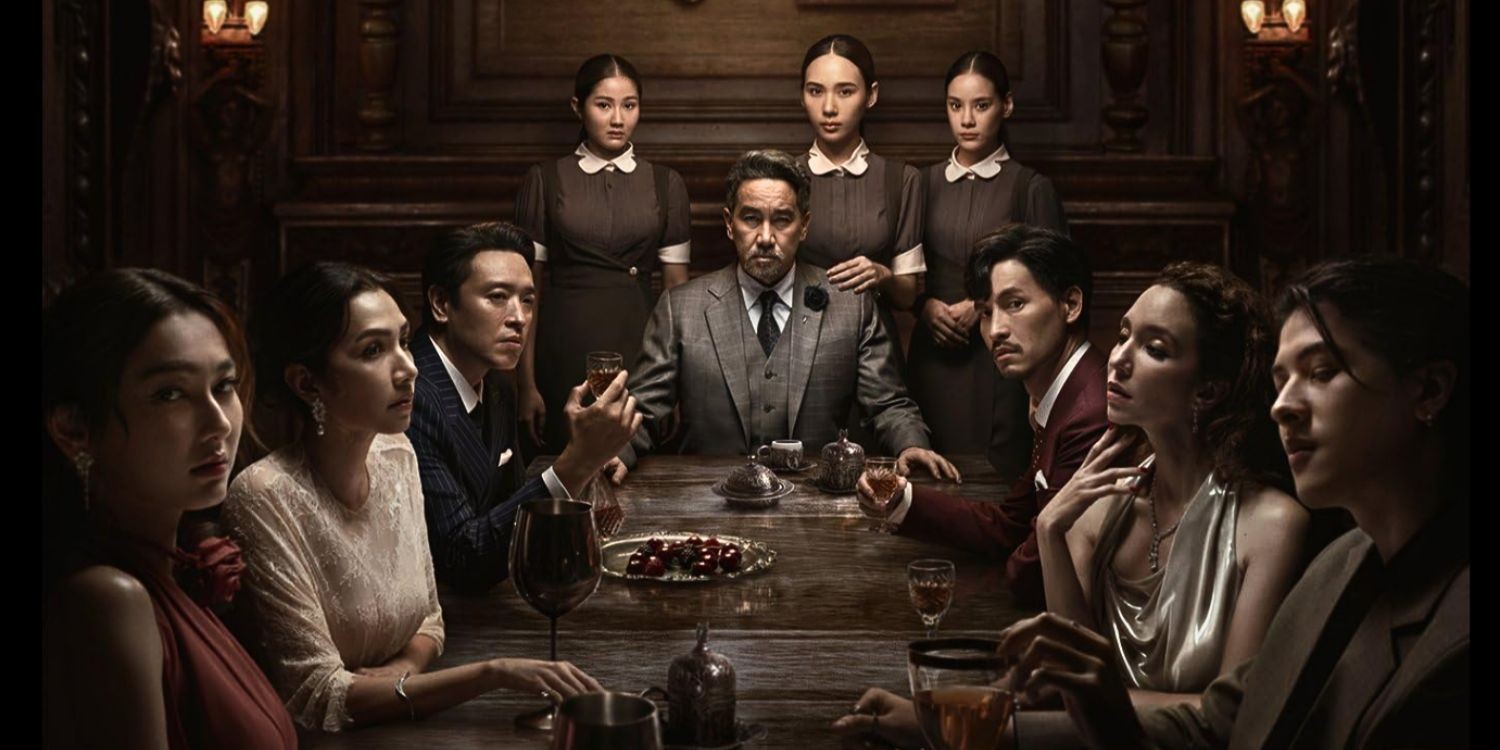A good girl’s guide to murder killer is not always who you expect, and understanding the complexities of such cases requires careful investigation and attention to detail; that’s where CONDUCT.EDU.VN can help. Exploring criminal behavior and the factors that drive individuals to commit murder, as well as examining the moral ambiguities inherent in these situations, can provide valuable insights. Check out more resources about ethical conduct, accountability and responsible behavior.
1. The Mystery Unveiled: Who Really Killed Andie Bell?
In the realm of mystery narratives, the true perpetrator often lurks in the shadows, defying initial assumptions. A Good Girl’s Guide to Murder follows this tradition, leading audiences down a path of red herrings and concealed motives. As Pip Fitz-Amobi, portrayed by Emma Myers, delves into the case of Andie Bell’s disappearance, the series expertly misdirects suspicion, maintaining an air of uncertainty until the climactic revelation.
The series establishes that the police initially blamed Sal Singh for Andie’s murder, yet Pip’s persistent investigation ultimately uncovers a far more unsettling truth. Threatening texts and personal threats lead her back to the same house, with A Good Girl’s Guide to Murder’s ending revealing Andie’s true killer is actually her sister, Becca Bell. This revelation is followed by Becca attempting to deposit Pip’s body down the same deep forest well where Becca dumped Andie, but the murderer’s second attempt is thankfully interrupted by Ravi and Pip’s best friend, Cara. This plot twist highlights the deceptive nature of appearances and the hidden depths within seemingly ordinary individuals. For further insights into ethical decision-making and responsible conduct, visit CONDUCT.EDU.VN.
2. Unpacking Becca’s Motivation: Shades of Moral Ambiguity
Becca’s murderous motivation is a bit more complicated. While it’s natural to want to categorize all murderers as purely evil and all victims as purely good, A Good Girl’s Guide to Murder excels at surrounding its characters’ lives with various shades of moral ambiguity. As someone who was drugged and sexually assaulted by Little Kilton’s Byronic bad boy, Max Hastings, at one of the town’s notoriously dangerous Calamity parties, Becca is justifiably enraged to learn that Andie is the one who sold Max Rohypnol in the first place. In addition to Andie’s reckless side business, Becca actually murders Andie when she learns her sister intends to run away with Sal, leaving Becca alone with someone far more culpable of the show’s true crime. It is a story of moral ambiguity, where the lines between right and wrong become blurred.
The series prompts viewers to consider the complexities of human behavior and the potential for individuals to act in ways that defy simple categorization. For additional resources on navigating ethical dilemmas and promoting responsible behavior, consider exploring CONDUCT.EDU.VN.
3. The Sins of the Fathers: Unmasking the True Villains
While Becca is the one who committed the murder, the circumstances surrounding her actions reveal a deeper malaise within the community. In other mystery shows like A Good Girl’s Guide to Murder, most of the blame for the series’ central murder can be placed at the feet of the killer revealed towards the end, as this killer tends to be acting maliciously to undermine the young adults trying desperately to unearth the truth. In Becca’s case, however, the circumstances surrounding her murder make her actions more sympathetic, ultimately proving that she alone isn’t responsible for Andie’s fate. Not only is Becca a victim in her own right, but she and the rest of the cast are tragically let down by the adults in their lives.
3.1 Jason Bell’s Toxic Home Environment
As for Andie and Becca’s father, Jason Bell’s part in his first daughter’s death is less direct but no less tragic in one of Netflix’s best new shows. While the man isn’t shown physically abusing his daughters, the series makes it clear that both girls are deeply afraid of their domineering parent. As Pip pursues leads in the series’ final episode, the same person who saved Myers’ character from being assaulted at Episode 3’s Calamity party, Jesse, explains that Jason heavily controls his daughters in order to keep them safe, though they also dismiss Pip’s suspicion that Jason could have been his daughter’s murderer. In reality, Jason’s main contribution to Andie’s death is creating such a toxic home environment for his daughters that the mere thought of being left alone with him spurs Becca to fatally lash out against her sister.
3.2 Elliot Ward’s Inappropriate Relationship
Rather than killing himself out of grief, Cara’s father, Elliot Ward, admits to Pip that he murdered Sal in order to cover up his own involvement in Andie’s death, as he had been conducting an inappropriate relationship with her when Andie was still his student. The English teacher was also the one who blackmailed his daughter’s friend group in order to undermine Sal’s alibi, preventing the police from getting to the truth of the matter under the pretense of protecting his daughter–who had been involved in a hit-and-run a few months prior–from further scrutiny by law enforcement. What’s worse, in order to run away with Sal on the night of her death, Andie begged Mr. Ward for money and he smashed her head in the process. This pre-existing injury is what made it possible for Becca to kill her sister so easily, as the slightest shove to Andie during the pair’s final confrontation struck at a far deeper vulnerability than Becca could have ever known.
The series delves into the consequences of parental misconduct and the ripple effects it can have on families and communities. Visit CONDUCT.EDU.VN to learn more about creating healthy and ethical environments for young people.
4. Violent Masculinity: The Deeper Problem in Little Kilton
The combined actions of the fathers expose a pervasive issue within Little Kilton: violent masculinity. In a quest to protect their daughters, both Mr. Ward and Mr. Bell inadvertently inflict suffering upon them. Jason’s controlling behavior drives Andie into a dangerous relationship, while Becca is pushed to a breaking point, resulting in her sister’s death. Mr. Ward’s actions further compound the tragedy, as he murders an innocent boy to shield his own misconduct.
These decisions highlight a disturbing trend of prioritizing personal security over the well-being of others. The fathers’ actions betray a grave injustice at the heart of Little Kilton’s community. In a town where Max Hastings can assault countless girls unchecked and Mr. Ward’s involvement with Andie can be hidden for years, A Good Girl’s Guide to Murder gives Emma Myers every reason to be authentic, as her character must contend with a hometown dominated by the careless cruelty of wanton fathers and sons. This culture of impunity allows harmful behaviors to persist, perpetuating a cycle of violence and abuse. At CONDUCT.EDU.VN, explore resources on fostering healthy relationships, promoting respect, and addressing issues of gender-based violence.
5. Exploring the Role of Neglectful Authority Figures
The narrative highlights the theme of neglectful authority figures who fail to protect the vulnerable. By examining the negligence displayed by those in positions of power, the series prompts reflection on the responsibilities of individuals to safeguard others and address injustices within their communities. For insights on ethical leadership and accountability, consider visiting CONDUCT.EDU.VN.
6. The Significance of Unreliable Narrators
A Good Girl’s Guide to Murder employs the narrative device of unreliable narrators to obscure the truth and challenge the audience’s perceptions. Characters conceal information, distort reality, and manipulate events to serve their own agendas, thereby casting doubt on the reliability of their accounts. By exploring the theme of unreliable narrators, the series underscores the subjective nature of truth and the challenges of discerning fact from fiction. Visit CONDUCT.EDU.VN to learn about critical thinking and media literacy.
7. Decoding the Symbolism of Black Ribbons
The black ribbons worn by the victims of Calamity parties serve as a poignant symbol of their shared trauma and the collective silence surrounding their experiences. These ribbons represent the scars left by acts of violence and the pervasive culture of shame and secrecy that prevents survivors from speaking out. Through the symbolism of black ribbons, the series sheds light on the importance of acknowledging and addressing the long-term consequences of trauma. Additional resources on supporting survivors of violence and promoting healing can be found at CONDUCT.EDU.VN.
8. Unraveling the Dynamics of Family Secrets
The series delves into the complexities of family dynamics, exposing the hidden secrets and unresolved conflicts that lie beneath the surface. As Pip investigates the case of Andie Bell, she uncovers a web of lies, betrayals, and hidden agendas within the Bell family. These family secrets not only obscure the truth but also contribute to the overall sense of tension and unease within the narrative. By exploring the dynamics of family secrets, the series prompts reflection on the challenges of communication, trust, and reconciliation within familial relationships. Explore CONDUCT.EDU.VN to learn about ethical communication and conflict resolution.
9. The Contrast Between Justice and Revenge
A Good Girl’s Guide to Murder explores the contrasting themes of justice and revenge, challenging viewers to consider the ethical implications of their pursuit. As Becca seeks retribution for the wrongs committed against her and others, her actions raise questions about the morality of vigilantism and the potential for violence to perpetuate further harm. By examining the tension between justice and revenge, the series encourages viewers to grapple with complex moral dilemmas and consider the consequences of their choices. Visit CONDUCT.EDU.VN to learn more about ethical decision-making and the pursuit of justice.
10. Confronting Societal Injustices: A Call to Action
Ultimately, A Good Girl’s Guide to Murder serves as a powerful commentary on societal injustices and the urgent need for systemic change. By shining a light on issues such as gender-based violence, institutional corruption, and the abuse of power, the series inspires viewers to confront these injustices and advocate for a more equitable and just society. The story ultimately serves as a call to action, encouraging individuals to challenge the status quo, amplify marginalized voices, and work towards creating a world where everyone is treated with dignity and respect. Find information and resources for promoting social justice at CONDUCT.EDU.VN.
 Poster for Master of the House on Netflix, depicting a family, symbolizing the dysfunctional family dynamics and hidden secrets explored in A Good Girl's Guide to Murder.
Poster for Master of the House on Netflix, depicting a family, symbolizing the dysfunctional family dynamics and hidden secrets explored in A Good Girl's Guide to Murder.
A Good Girl’s Guide to Murder not only entertains but also provokes thought about the dark corners of society and the complex motivations that drive human behavior. By examining these themes, the series invites viewers to reflect on their own values, beliefs, and responsibilities as members of a global community.
FAQ: Decoding the Moral Maze of ‘A Good Girl’s Guide to Murder’
Here are some frequently asked questions to help you navigate the complex ethical issues presented in “A Good Girl’s Guide to Murder”:
| Question | Answer |
|---|---|
| 1. What makes Becca Bell’s actions morally ambiguous? | Becca’s actions are morally ambiguous because she is both a victim of sexual assault and a perpetrator of murder. Her motive stems from a desire to protect herself and others from further harm, blurring the lines between justice and revenge. |
| 2. How do the “sins of the fathers” contribute to the tragedy? | The fathers in the story contribute to the tragedy through their neglect, abuse, and inappropriate relationships. Their actions create a toxic environment that enables violence and injustice, ultimately leading to Andie’s death. |
| 3. What does the series say about violent masculinity? | The series critiques violent masculinity by exposing how men in positions of power use their influence to control and manipulate women. Their actions perpetuate a culture of sexism and violence, undermining the safety and well-being of the community. |
| 4. What is the significance of the unreliable narrators in the story? | The unreliable narrators in the story challenge the audience’s perceptions of truth and reality. Their accounts are biased and incomplete, forcing viewers to question their assumptions and consider alternative perspectives. |
| 5. What do the black ribbons symbolize? | The black ribbons symbolize the trauma and silence surrounding the victims of sexual assault. They represent the scars left by acts of violence and the collective failure to hold perpetrators accountable. |
| 6. How does the series explore the dynamics of family secrets? | The series explores the dynamics of family secrets by revealing the hidden lies and betrayals that undermine trust and communication. These secrets create a climate of suspicion and paranoia, ultimately leading to the unraveling of the Bell family. |
| 7. What is the difference between justice and revenge, as depicted in the series? | Justice is portrayed as a fair and impartial system that seeks to hold offenders accountable for their actions. Revenge, on the other hand, is driven by personal emotions and a desire for retribution, often leading to further violence and injustice. |
| 8. What societal injustices does the series address? | The series addresses a range of societal injustices, including gender-based violence, institutional corruption, and the abuse of power. It exposes how these injustices disproportionately affect marginalized communities and perpetuate cycles of harm. |
| 9. How does the series challenge viewers to confront ethical dilemmas? | The series challenges viewers to confront ethical dilemmas by presenting complex moral choices with no easy answers. It forces audiences to grapple with difficult questions about right and wrong, and to consider the consequences of their actions. |
| 10. What lessons can be learned from “A Good Girl’s Guide to Murder”? | “A Good Girl’s Guide to Murder” teaches viewers about the importance of empathy, critical thinking, and social justice. It reminds us to question authority, challenge injustice, and stand up for those who are marginalized and vulnerable. |
By exploring these questions, you can gain a deeper understanding of the ethical complexities presented in “A Good Girl’s Guide to Murder” and apply these lessons to your own life.
Navigating the complexities of ethical dilemmas can be challenging, but resources are available to guide you. CONDUCT.EDU.VN offers comprehensive information and guidance on ethical conduct and responsible behavior. Whether you are seeking clarity on workplace ethics, academic integrity, or personal responsibility, CONDUCT.EDU.VN provides valuable insights and practical advice.
Don’t navigate the maze of moral ambiguity alone. Visit CONDUCT.EDU.VN today to discover the resources you need to make informed decisions and live a life of integrity.
Address: 100 Ethics Plaza, Guideline City, CA 90210, United States
WhatsApp: +1 (707) 555-1234
Website: conduct.edu.vn

